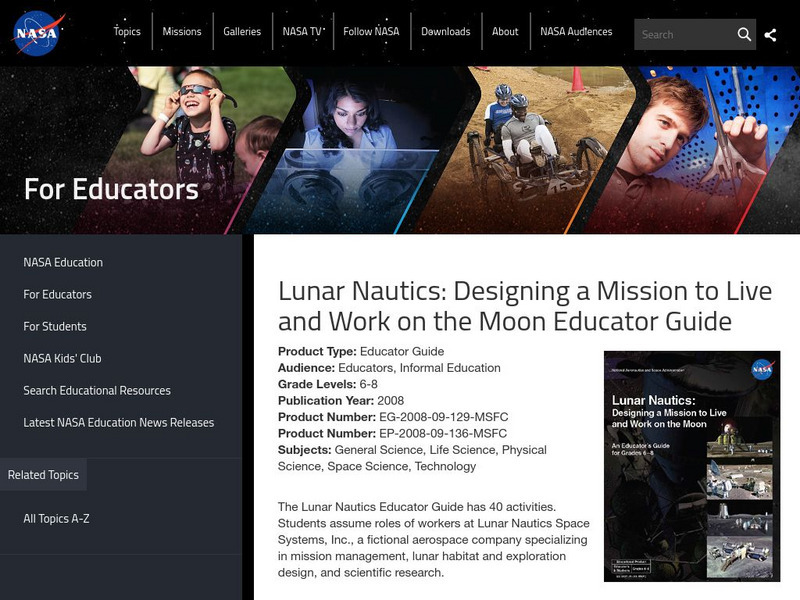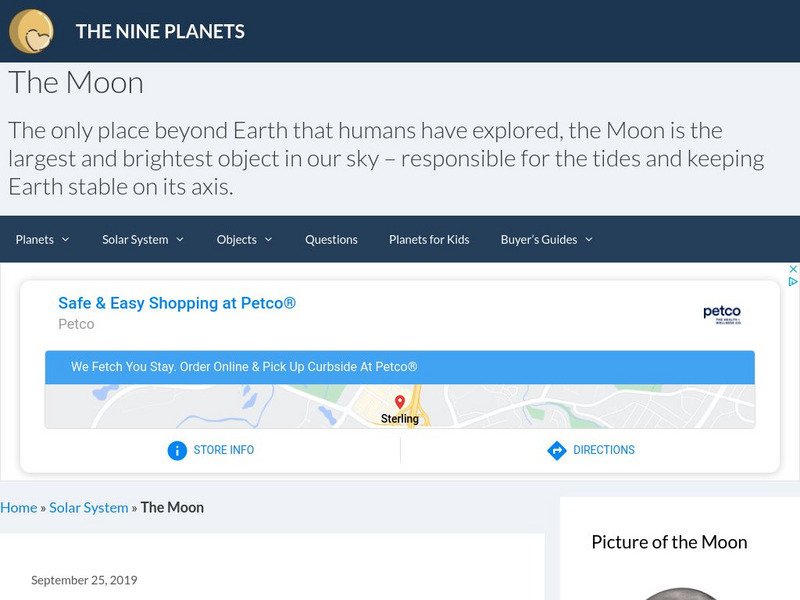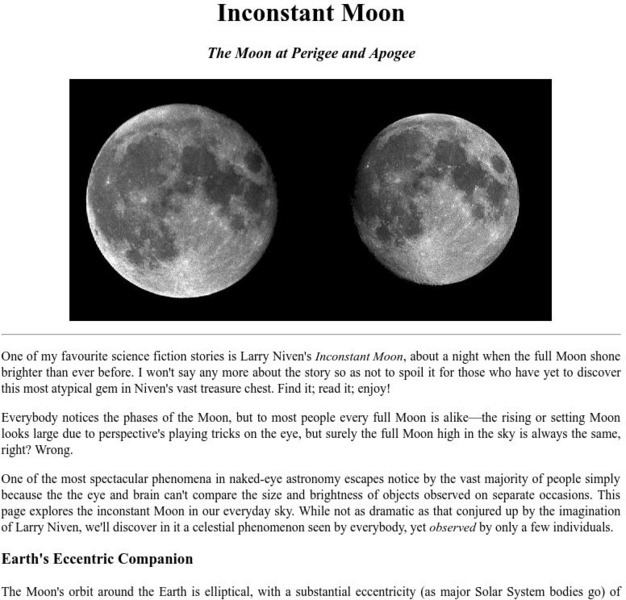NASA
Nasa: Moon Munchies Educator Guide
This educator guide provides teachers with an outline for the entire Moon Munchies unit. Students will be able to design and build a lunar plant growth chamber using the Engineering Design Process.
NASA
Nasa: Lunar Nautics: Design Mission to Live & Work on Moon Educator Guide
This guide provides students the opportunity to simulate working at an aerospace company. Activities include designing a lunar lander and robot, building spacecraft, and much more.
Nine Planets
The Nine Planets: The Moon
Explore the mythology, structure, observational history, gravitational force, and orbit of Earth's Moon.
Sophia Learning
Sophia: Bill Nye: Once in a Mega Moon
Bill Nye explains why the moon appears smaller when it is higher in the sky, and he presents a Home Demo experiment that proves its an illusion. The experiment requires a bright moon on a clear night, a stiff piece of cardboard, and a...
Annenberg Foundation
Annenberg Learner: Moon Journal Activity
Students use the process of journaling to make discoveries about the moon. This activity involves having students write observations about the moon in a journal. Using their observations they go to an online resource and choose...
Other
Planetary Society: Relative and Absolute Ages in Histories of Earth and the Moon
A lengthy scholarly article that discusses the geologic time scale, its history of development, age-dating events that occurred in different eras, and how absolute and relative dating are used to assess the ages of the Earth and Moon....
Other
First Men on the Moon: Experience the Apollo 11 Lunar Landing
Watch, listen, and relive the excitement of the Apollo 11 lunar landing as experienced minute-by-minute by the courageous crew of Apollo 11 and Mission Control.
Globio
Glossopedia: Moon
Orbiting around Earth at an average distance of 384,392km is our constant companion, the Moon. This and a great deal more can be learned about our closest neighbor in this article by GLOBIO
NASA
Nasa: Diameter of the Moon: Grades 4 12
This lab activity allows students to calculate the diameter of the moon using proportions. Also follow links to other NASA lesson plans.
NASA
Nasa: Exploring the Moon Educator Guide
This NASA educator guide provides teachers with an outline for teaching a unit about the Moon. Find lessons and hands-on activities about the different parts of the Moon and lunar landing sites.
NASA
Nasa: Packing Up for the Moon Educator Guide
Use these lessons to help students understand more about the preparation it takes to go to the moon. Students will play an active part in decided what to take to the moon when given a specific objective. Includes PDF's (require Adobe...
NASA
Nasa: Earth's Moon: Overview: Our Natural Satellite
Prepared by NASA, this site provides a detailed look at the Earth's moon. The menu tabs are divided into overview, photo gallery, and facts and figures.
Utah Education Network
Uen: Trb 3:1 Investigation 3 What Is Moonlight?
Understand that the moon shines by reflecting sunlight.
Utah Education Network
Uen: Trb 3:1 Investigation 1 Comparing the Earth & Moon
Third graders compare the earth and the moon in this activity.
Utah Education Network
Uen: Bouncing Sunlight
The light we see from the moon at night is light that the moon reflects from the sun.
PBS
Pbs Learning Media: Phases of the Moon
When we look up at the night sky, why do we see the Moon's appearance changing over time from a full sphere to a crescent to nothing at all? Find the answers in this interactive resource adapted from the National Air and Space Museum.
PBS
Pbs Learning Media: Why Doesn't the Moon Fall Down?
In this animated video segment adapted from NASA, astronomer Doris Daou explains how the forces of speed and gravity keep the moon in a constant orbit around Earth. [1:36]
PBS
Pbs Learning Media: Explore the Moon
See what it is like to walk on the moon by viewing this collection of QuickTime images from NOVA Online. Stunning 360-degree panoramas from each of the six successful Apollo moon landings are featured.
Utah State Office of Education
Utah Science: What's Up There Anyway?
Far out there we observe the moon, its phases, and its constant changing position as we sit on a swing in the backyard. Investigate the science behind the moon through the activities provided.
Digital Public Library of America
Dpla: Race to the Moon
In 1955, the US and the USSR each announced plans to launch a satellite into orbit. Thus began the race to the moon. Throughout the 1960s and 1970s, the American space program and its new classes of astronauts achieved breakthroughs in...
Fourmilab Switzerland
John Walker: Inconstant Moon: Moon at Perigee and Apogee
Most people think of every full moon as appearing the same, but careful observation allows us to see that sometimes the Moon appears larger than at others. This is caused by the elliptical orbit of our natural satellite.
Extreme Science
Extreme Science: The Moon
Read about the birth of Earth's moon, its composition, orbit, visible phases, and other interesting facts. Link to a virtual moon phase interactive which shows the current lunar phase and the phase on any date in the past or future.
Library of Congress
Loc: Poetry 180: The Moon
This one-stanza poem describes a half-moon in an original way.













